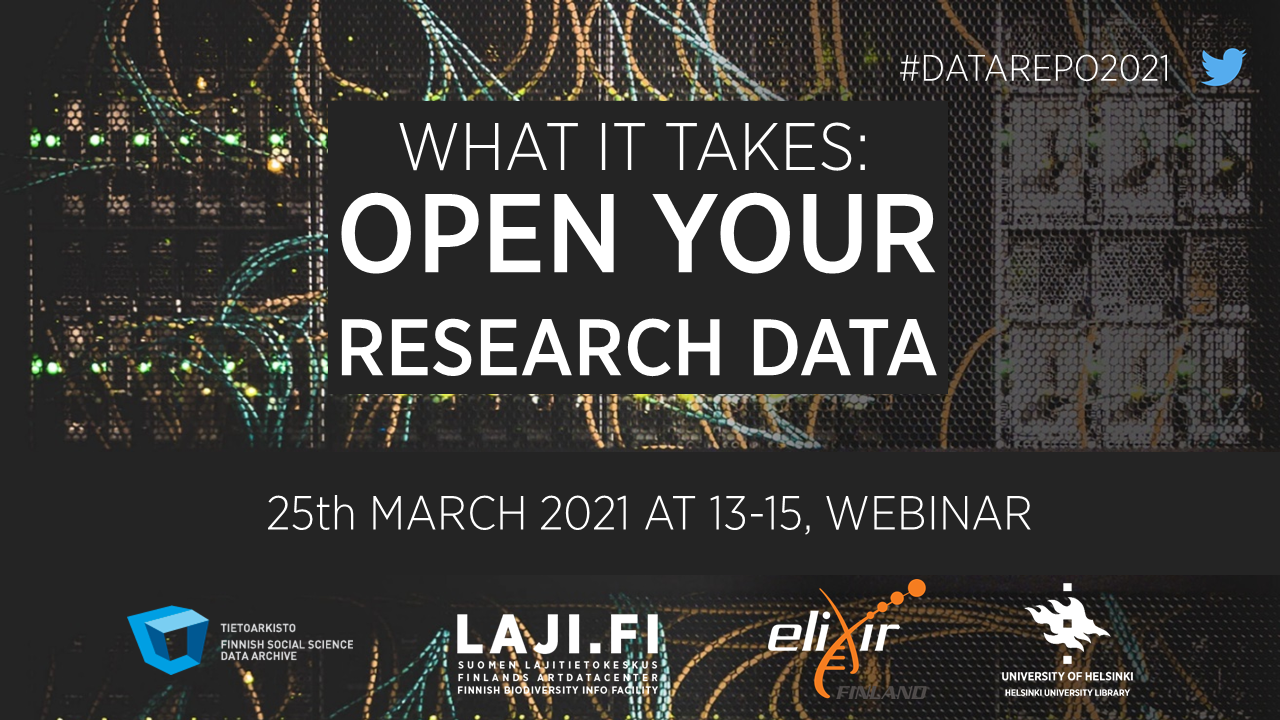”I wish that the funding bodies and publishers would not only demand for research data to be dumped in an open repository as it is, but it should be required that the data is stored in an open access repository in a standard data format(s), so that it can be found and reused”, says Kari Lahti, a director of Biodiversity Informatics Unit at the Luomus. Lahti is one of the speakers at the webinar event ”What it takes: Open your research data” that takes place on 25 March 2021.
Kari Lahti (TUHAT, @KariLahti1) is currently working as a director of Biodiversity Informatics Unit at the Finnish Museum of Natural History Luomus at the University of Helsinki, and he is also a manager of Finnish Biodiversity Information Facility (FinBIF, Laji.fi). In this interview, he stresses that openly available data can be a crucial component in solving problems in the field of biodiversity and human health, and it is important also for good governance and decision-making: ”Open access or easy access by demand to data is a precondition for improved trust in our society as a whole.”
More thoughts from Kari Lahti will be heard in the webinar ”What it takes: Open your research data” that takes place on 25 March 2021 – #datarepo2021 on Twitter.
Kari Lahti, could you tell us a little about yourself?

”I am a biodiversity informatics professional with MSc on biology. My working history is quite diverse from protected area practitioner as a regional superintendent of national parks and currently I work as a director of Biodiversity Informatics Unit at the Finnish Museum of Natural History Luomus at the University of Helsinki. I have been working quite intensively within nature conservation landscape nationally as well as internationally e.g. as a secondee for IUCN headquarters in Switzerland under the protected areas programme and representing Finland as a national focal point for UN Convention on Biological Diversity (CBD) Programme of Work on Protected Areas (PoWPA).”
”I act, in my current position, as a manager of Finnish Biodiversity Information Facility (FinBIF, Suomen Lajitietokeskus, Laji.fi), which was officially launched as a service 2016 and continuously developed by the ICT team at the Biodiversity Informatics Unit. I am a huge supporter for open science and open data and thus focus on mobilising all available biodiversity related data benefiting cutting edge science, research and good decision-making in the field conservation and sustainable use of natural resources. Digitalisation in general and digitisation of information is a core activity by FinBIF and sharing the data with FAIR principles is the key objective.”
Digitalisation in general and digitisation of information is a core activity by FinBIF and sharing the data with FAIR principles is the key objective.
What do you see as the greatest benefit of opening research data?
”The potential of the use of open data is beyond comprehension. When we add the concept of ’linked open data’ (LOD) to the open research data, the doors are open wide. Currently, there are extremely interesting far-reaching outcomes of the use of data provided by GBIF (Global Biodiversity Information Facility).”

”There are ample examples of issues, like vector-borne diseases and the geospatial and geographic components of disease transmission, where open biodiversity data can be demonstrated as a crucial component in solving problems in the field of biodiversity and human health. Another dimension, in addition to wide scope research, is open data for good governance and decision-making. Land-use planning, use of natural resources, conservation measures, few to mention, needs accurate, up-to-date, comprehensive biodiversity data. Besides the open data, there is critical need for restricted-use data that must be findable for all and accessible for authorised use.”
Another dimension, in addition to wide scope research, is open data for good governance and decision-making. Land-use planning, use of natural resources, conservation measures, few to mention, needs accurate, up-to-date, comprehensive biodiversity data. Besides the open data, there is critical need for restricted-use data that must be findable for all and accessible for authorised use.
If you would have one wish that would advance opening data (regardless of costs), what would it be?
”I wish that the funding bodies and publishers would not only demand for research data to be dumped in an open repository as it is, but it should be required that the data is stored in an open access repository in a standard data format(s), so that it can be found and reused.”
How do citizens benefit from open research data (give us an example)?
”The decisions made based on restricted-use, non-accessible and non-standardised data (e.g. research data) will not fulfil the criterion on transparency. Too often, citizens have no other choice but accept and trust that decisions made concerning their interests are based on trustworthy data. Currently there is a rapidly growing mistrust against the authorities, and corruption even in Finland seems to more common than anyone believed still quite recently. Therefore, open access or easy access by demand to data is a precondition for improved trust in our society as a whole. It is also needed that the data must be in a standard data format for those interested to understand the content.”
Too often, citizens have no other choice but accept and trust that decisions made concerning their interests are based on trustworthy data.
Interview series on open data (#Datarepo2021):
- Open data as the foundation of interdisciplinary research – interview with Francesca Morello (23.3.2021)
- Open data in regular use as part of work – interview with Jouni Tikkanen (22.3.2021)
- The importance of infrastructures and unprecedented potential of open data – interview with Tuomas Alaterä (18.3.2021)
- Researchers need tools, services and ”data doctors” to manage and open their data – interview with Mietta Lennes (16.3.2021)
- Mobilising data for research and decision-making – interview with Kari Lahti (11.3.2020)
- The beauty of the unknown – why open your research data? (17.2.2020)

